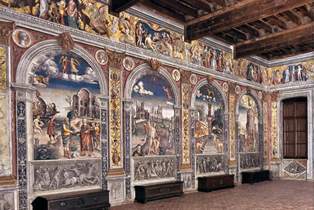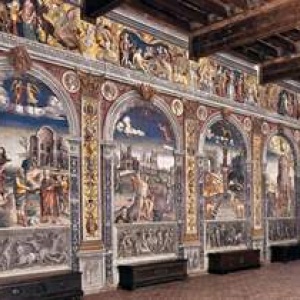
WTI Magazine #11 2014 Jan, 3
Author : Enrico De Iulis Translation by: Alessandra Bitetti
During the Italian Renaissance it wasn't uncommon to decorate rooms, halls or courtrooms with an astrological subject. The works of the "Palazzo della Ragione" in Padua survived to this day. This calendar and astrological decoration even "helped" in the interpretation and understanding of legal cases according to the sign of the zodiac of the person indicted.
In the "Palazzo Schifanoia" in Ferrara, the activities of the Estense Court were described and marked by the complex iconological work divided into horizontal band for months, signs of the zodiac and even for its "decani" representation (the three divisions each of circa ten days over the course of a period underneath a Zodiac sign), deduced from very rare books with Middle East and Arab ancestry.
In the Villa Farnesina in Rome, where in a complex, erudite and precious iconological building, the astrological chart of the client Agostino Chigi is inserted in the frescoes close to the planets in their deities features and to episodes of classical mythology deduced from the Ovidio's "Metamorphoses" or from '"Golden Donkey" and "Cupid and Psyche" by Apuleius, there is a huge production of frescoes and paintings where the gods/planets - represented on their triumphal chariots – are called to preside over activities, births, alchemical or philosophical meanings.
In Mantua, we have a singular case: it is Palazzo d'Arco. The cycle of frescoes in the hall of this building is clearly inspired to the zodiac, but in this case there are no human activities or planets that govern the signs. In the large arches that mark the walls, we have episodes sometimes drawn from myths in an original way, elements of royal archeology, and scenes of a symbolic nature not always easy to interpret.
The author of the work is Giovanni Maria Falconetto, a painter from Verona from the beginning of the 1500s who doesn't come off in his style from the late 1400 tradition, but remains very close to the school of Lorenzo Costa, a painter from Ferrara who was very active in the small kingdoms of the Po Valley of the time.
The whole hall shows a deep scholarly and very punctual preparation, but it leaves many unresolved questions such as the identity of the old figure at the base of the Cancer month, which is believed to be the one who commissioned the work, even if the building is linked to the name of Luigi Gonzaga, also called Rodomonte, that was only twenty years old at the time of the fresco.
The second, much more interesting mystery, is that a room in the Palazzo Della Rovere in Rome, named "of Penitentiaries", painted by Pinturicchio and now very pale, is pretty much the source of inspiration for the whole cycle, but no one has yet discovered what kind of relationship there was between the two buildings, and especially between the two clients of the works. For sure it is not a simple copycat by Falconetto to the work of Pinturicchio, because at those time the client, not the artist, was the one to decide the theme of the artistic work. So it's unlikely that such a refined and particular iconological choice had been entirely taken and copied without a real relationship between the two places, or between the two client families.





